A trio of Texas congressmen have introduced the Texas Coastal Spine Authorization Act in both the U.S. Senate and U.S. House of Representatives in an effort to ensure the U.S. Army Corps of Engineers receives the green light to proceed with work outlined in the Coastal Texas Protection and Restoration Study.
The $31 billion project, designed to shield the upper Texas Gulf coast from hurricane-related storm surge, was authorized in H.R.7776, the Water Resources Development Act of 2022, which the House passed June 8. The legislation was referred to the Senate the following day, but the Senate so far has not voted on the bill.
U.S. senators John Cornyn and Ted Cruz and U.S. Rep. Randy Weber, all Republicans from Texas, each released statements announcing introduction of the stand-alone legislation July 26.
“Protecting the Texas Gulf Coast isn’t just an important local priority—it’s a national imperative,” Cornyn said. “Our coastal communities are home to millions of Texans and pivotal industries that fuel our country and economy. This bill will ensure our coastline has the necessary infrastructure to help protect against future storms, and I will continue fighting for this project.”
Lt. Gen. Scott Spellmon, the 55th U.S. Army chief of engineers, signed the Chief’s Report for the Coastal Texas Protection and Restoration Study in September 2021. His letter outlined the major components of the project, often referred to locally as the “Ike Dike” in reference to Hurricane Ike, a 2008 hurricane that made landfall at Galveston Island. The project includes multiple lines of defense. Major components include improvements to the existing Galveston seawall, construction of a system of gates across Bolivar Roads and a beach and dune system across Bolivar and West Galveston. The study area stretches across the entire length of the Texas coast.
“In Texas, we know how destructive storms and natural disasters can be,” Cruz said. “A coastal barrier protection system will reduce the impact of hurricanes and tropical storms and help keep Texas communities safer. It’s not only an important safety measure, but it will save money in the long term by softening the destructive power of storms along the Gulf Coast. This is a win-win, not just for Texans, but for taxpayers nationwide.”
Weber, who sponsored the House version of the bill, also highlighted the role the Texas coast plays in the energy supply for the nation.
“The coastal barrier is a matter of national security,” Weber said. “The Texas Gulf Coast is home to millions of people, countless homes and jobs and numerous refineries. The Texas Coastal Spine Authorization Act will strengthen the resiliency of the Gulf Coast. It’s imperative that we complete this critical barrier protection as soon as possible, since it’s a question of when—not if—another big storm barrels up the upper Texas Gulf Coast.”
The Coastal Texas Protection and Restoration Study was a six-year, $20 million study by the U.S. Army Corps of Engineers, along with the Texas General Land Office (GLO), the non-federal sponsor for the project. As the non-federal sponsor, the Texas GLO would be responsible for 35 percent of the estimated $31 billion project. The Corps estimates a construction duration of between 12 and 20 years, depending on funding availability, with a project lifespan of 50 years. Annual costs of operation and maintenance of the project would be about $1.2 billion, the Corps estimates, with the average annual benefits estimated at $2.3 billion, for an annual benefit-to-cost ratio of 1.9 to 1.
The bills awaiting congressional consideration would only authorize the project, which would require subsequent legislation to supply funding.
The surge barrier components of the project will include two 650-foot-wide sector gates and two 125-foot-wide sector gates, fifteen 300-foot-wide vertical lift gates, and ninety-six 16-foot-wide shallow-water environmental gates. Ship traffic going to and from the Houston Ship Channel would use the sector gates across Bolivar Roads.
The plan has been met with some resistance from environmental and community groups, not on merit, but rather because, for Tier I components of the study, some uncertainty remains as to the potential impacts, with further modeling needed. According to the final EIS from the Corps, additional study in accordance with the National Environmental Policy Act will be conducted during the preconstruction, engineering design (PED) phase of the project “to more accurately disclose the impacts based on refined designs and updated modeling.”
Tier I components include all of the structures and shoreline enhancements described above.
Caption for photo: Renderings of Tier I structures included in the Coastal Texas Study, with vertical lift gates closed, left, and open, right. (Courtesy of Texas General Land Office)




